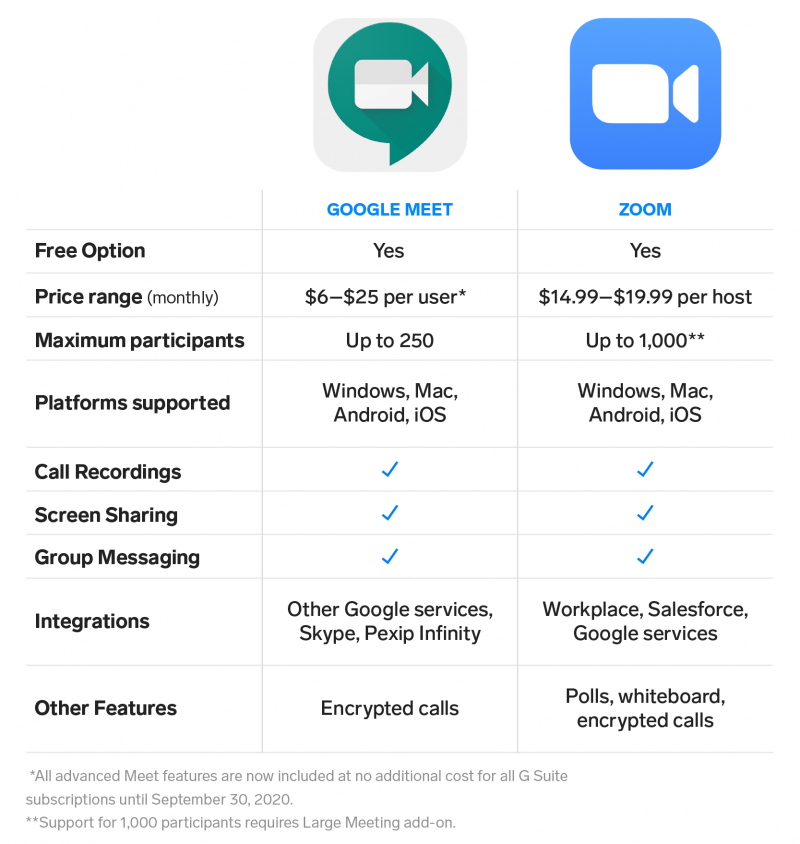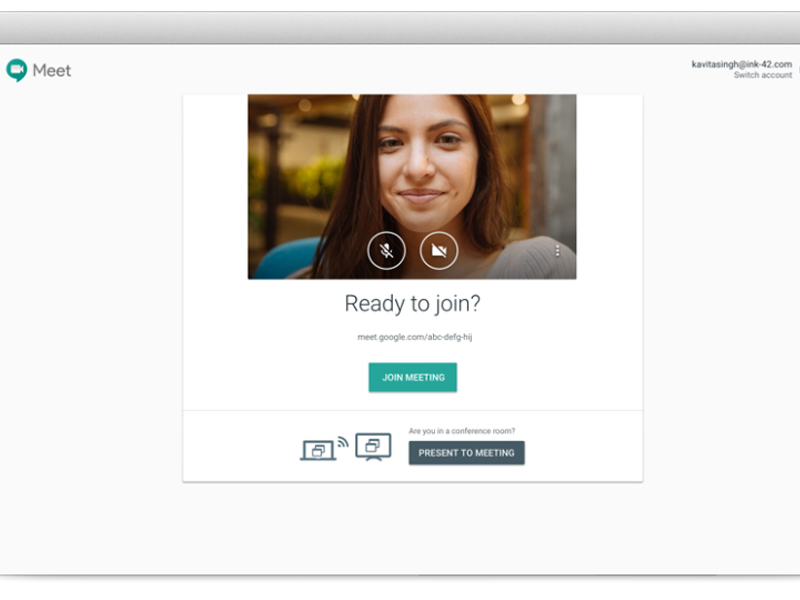- More and more people are learning and working from home, especially in response to continued measures being taken to help combat the spread of coronavirus.
- As a result, you might need access to a good video conferencing platform – and two of the best are Google Meet and Zoom.
- Though both platforms have their advantages, Zoom is ultimately the more comprehensive video conferencing solution.
- If you’re studying or working remotely and need recommendations for gear and gadgets to help your productivity, be sure to check out our roundup of the best work-from-home tech.
With more and more people attending virtual classrooms and working from home, you might be wondering what the best way is to communicate with your colleagues, teachers, and classmates. Thanks to web-based tools, there are plenty of options for communicating online, ensuring that you can learn and work from home with ease.
Two of the most popular online communication tools are Google Meet and Zoom, which are used by workplaces and classrooms around the world. Both services provide the ability to interact with other participants through video conferencing, enabling businesses and schools to conduct video meetings and lessons through a variety of apps and devices.
But which of these tools is ultimately better? And which might work best for your needs? We put Google Meet and Zoom head to head to find out.
Updated on 7/30/2020 by Steven Cohen: This article has been revised to include details about new features for each service. We've also addressed virtual classroom applications for both platforms in addition to work-from-home needs.
Google Meet vs Zoom: which is better?
Google Meet and Zoom are both video conferencing services, and at their core, they offer similar features. Each platform has its own strengths and weaknesses, however, and one service may be a better fit for your needs depending on the size of your team and what other applications you plan to use.
When it comes purely to video conferencing features, Zoom has the edge over Google Meet, offering a comprehensive assortment of options at various price points. Zoom's most expensive plan provides support for the largest number of participants, and the company also offers a free plan that could be useful for smaller teams.
With that said, if you're looking for a larger collection of applications to use in tandem with your video conferencing service, then Google Meet might be a better fit. The platform, formerly known as Google Hangouts Meet, comes bundled with other helpful Google services as part of the company's G Suite subscription. A new free option is also available to all Google users.
Feature comparison

Pricing and plans

Google Meet and Zoom are both available in a variety of plans for different monthly costs, with certain features only available via certain packages.
The most basic version of Zoom is available for free, but there are some limitations to this option. Notably, you can only host meetings of up to 100 people, and group meetings can only be up to 40 minutes. That said, those limitations may not be a problem for many smaller teams.
Pricing for Zoom can get a little complicated if you need more than what the free version has to offer. The step up from the Basic plan is the Pro plan, which costs $14.99 a month per host and allows meetings of up to 24 hours, personal meeting IDs, and more.
Next up is the Business plan, which comes in at $19.99 a month per host with a minimum of 10 hosts. This option allows up to 300 participants, and adds some advanced administrative features that only some will need.
Last but not least is the Enterprise plan. This option is also $19.99 a month per host, but it requires a minimum of 100 hosts. The Enterprise plan offers support for up to 500 participants and includes even more advanced features, like dedicated customer service and unlimited cloud storage. An Enterprise Plus upgrade is also available with support for up to 1,000 participants.
Outside of its workplace plans, Zoom also has specific solutions geared toward education. Education plans are available for a minimum of 20 hosts and a max of 149 hosts. Each host can have unlimited meetings with support for up to 300 participants. You can find more information on pricing and features for Zoom's Education plan here.
When it comes to Google Meet, you also have a few different options to choose from. Though a free version of Meet wasn't originally available, Google now offers free access to a limited version of the service to all of its members. The free version of Google Meet supports up to 100 participants and a meeting duration of 60 minutes. With that said, the 60 minute time limit will not be imposed until after September 30.
To unlock more features, you'll need to pay for Google Meet as part of a subscription to Google's G Suite catalog of services. G Suite is available for as little as $6 a month per user, and as much as $25 per user a month as part of the Enterprise plan.
The Basic version of G Suite, which comes in at $6 per month, allows video calls of up to 100 participants, while the $12 per month Business plan allows up to 150 participants, and the Enterprise plan offers up to 250 participants. Enterprise also offers support for other advanced features, like recording meetings and livestreaming.
With that said, Google is now offering a special promotion in response to the current health crisis related to the spread of coronavirus. To help businesses and schools communicate during the emergency, Google is now offering all G Suite subscribers access to the Enterprise edition of Meet at no extra cost. The additional features will be available until September 30, 2020.
Like Zoom, Google also offers education specific Google Meet and G Suite solutions. You can find more information about G Suite for education here.
Extra features

Zoom is a dedicated video conferencing service built by a company that is mainly focused on building the Zoom service. As such, the platform is a little more comprehensive than Google Meet. Sure, Meet scores some points because of its seamless integration with other Google apps, and the fact that it comes bundled with a host of other services, but if you're really only looking for a video conferencing platform, those other services won't matter all that much.
Notable added features include things that may help make video calls a little more productive. For example, you'll get the ability to conduct polls, the ability to share a whiteboard that participants can collaborate on, the option to add support for up to 1,000 participants for an extra fee, and more. Not everyone will need these features - but for some teams, these abilities could be the deciding factor between signing up for Zoom and signing up for Google's G Suite.
Both Meet and Zoom also offer some features that you would expect, like call encryption, support for up to 720p HD video, and presentation modes that allow for screensharing to other participants. Google Meet has also made some improvements over the last few months by adding additional options that are found on Zoom, like a tiled layout for larger calls which resembles Zoom's Gallery View.
That said, Google's tiled layout maxes out at 16 people, while Zoom's Gallery View supports up to 49 people (depending on your CPU). In general, apart from the other Google services you get with G Suite, Meet itself doesn't offer many features that Zoom doesn't also provide.
Integrations

Perhaps one of the most important things to consider is how each platform integrates with other services. Notably, Google Meet allows users to integrate meetings with other teams using Skype for Business, and other video meeting systems based on the SIP and H.323 standards. Meet also integrates with additional apps, including other Google services. For example, the service integrates well with Google Calendar
Zoom offers some great integrations too - including some Google apps and services. For example, Zoom integrates with Facebook Workplace, Skype for Business, Salesforce, Microsoft Outlook, Google Drive, Google Calendar, and more. Safe to say, while Meet may make integration with Google services a little easier, Zoom still allows many of those same integrations as well.
The bottom line

Ultimately, Zoom is the more comprehensive platform, but that doesn't necessarily mean that it's the right option for everyone. If you simply want the best video conferencing platform, then Zoom is the way to go.
That said, if you don't need all the features offered by Zoom, and instead want the other G Suite services included with a G Suite subscription, then Meet will be more than good enough for your remote work or learning needs.
You can get Google Meet from the G Suite website, or sign up for Zoom at the Zoom website.
